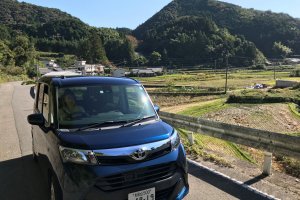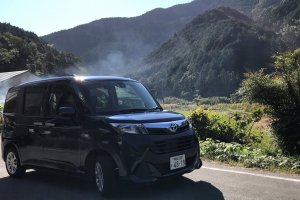In autumn 2020 I went on a weekend road trip with my friend. We drove around the north of the Kii Peninsula where Wakayama Prefecture meets Osaka Prefecture and explored the Kimino area. Where is Kimino, you might asked, and what is there to visit?

There is nothing here…
Kimino has the administrative status of a town but it is actually a cluster of villages located in the mountains. It looks very empty and indeed Kimino has a population of only 8,600 people who live in 4,200 households (data from March 2021). You can imagine that there are many elderly living alone in their houses. Having said that, Kimino has a fair share of restaurants and cafes and they are operated by the younger generation.
It is surrounded by better known places, at least to the Japanese, like Arida, Kainan and Katsuragi, and it is not far from very popular Koyasan. Even though it is also within easy reach by car of Kansai International Airport, this place has seen Zero tourists in the middle of a tourist boom pre-Corona. Kimino Town even put a promotion video together where children explain what the appeal of their hometown is: namely, that there is nothing….no train station, no supermarket, nothing fancy at all.
Kimino does not feature in any trip listings and it seems to be hiding away in the mountains of the Kii Peninsula. So, what is there? Actually quite a bit to make it worth your while.

The Nishi Koya Kaido
This is an old pilgrimage trail that connected Kyoto with Koyasan. You might know that there were seven roads that lead to the top of Koyasan. One of these roads came from Kyoto where people boarded a boat and travelled down the Yodagawa River to Osaka. Then in the Shimotsu area, now Kainan City, they began their accent towards Koyasan. This old road now follows more or less Road 370 from Kainan to Koyasan. The 10 temples are located in Nagamine, a valley that has been considered a reijo (a spiritual area).
There are still 10 temples located along the trail, including the Kamataki Yakushi Kongo-ji temple. This temple counts as no. 5 amongst the 10 temples. Yakushi, the Medical Buddha, has been venerated here. This temple has existed since the year 830. This was the Heian period of Japanese history. The temple’s origin is said to be a small hall with a Buddha statue in it that was erected on top of the mountain by local village people. This is unusual because most temples in Japan were founded by powerful families, by emperors or warlords.
Ennin, a disciple of Saicho, a Japanese Saint and Founder of Tendai Buddhism on Mount Hiei, passed by here. You can call Saicho (767-822) the competitor of Kukai, or Kobo Daishi (774-835), another Saint, who set up his monastery on Koyasan. This Ennin travelled from Mount Hiei to Koyasan along this old pilgrimage trail and he stopped by this temple.
During the Kamakura period of Japanese history a Mr. Senju who belonged to a powerful family in Hineno sponsored a new temple building here when he sought help from the Medical Buddha to cure his eye disease. He had red eyes because of an eye infection and the story goes that he prayed to Yakushi here at this temple and got promptly healed. This is still what this temple is famous for: curing eye diseases.
16th century warlord Oda Nobunaga, whose soldiers burned down many temples, also came here and burned the temple hall to ashes. The statue of the Medical Buddha could be saved and hidden, and it was re-installed in a new temple hall that was built 130 years ago.
Many pilgrims must have come here in the old days. The steps leading to the temple look quite used from many people walking across. Nowadays it is very quiet here. Hardly any pilgrims come this way anymore and not many visitors either. This temple runs a Shukubo, a temple lodging and they offer Ajikan meditation and Shakkyo, sutra copying experiences.

Ōketsu, a hole in the river
The temple is located near a waterhole in the river. It is a round stone basin that looks like a kamado, an old-style cooking stove. This kama gave the area its name: Kamataki. Locals explained that millions of years ago, there must have been a waterfall here and the gushing water created this hole, which is 2 meters times 2 meters.
This waterhole is still there in the river and it was even declared a “National Monument”. One can see the hole when the water level is low. So, don’t come here after a rainy day.
When I went looking for this local attraction in the river, I met a local guy who comes here to catch eel.

Aserina – Washi Paper Workshop
Next door to the temple is an old earthen storage house. It was been renovated and is now being used as a washi studio. The couple who runs the washi studio moved here some years ago. They are now also running washi-making experiences and their studio is open to buy washi paper and items made from washi. For those who book a temple stay next door, coming here for a washi-making experience might be an interesting option.

Fudo Waterfall and Rural Landscape
The Fudo Waterfall is a nice spot off the main road, if you can call the small country lane a main road. The waterfall is named after Fudo Myoo, a Buddhist deity that is typically seen with an angry looking face, surrounded by a halo of fire and holding a sword and a lasso. He is an important deity in Japanese Esoteric Buddhism, to which both the above-mentioned Shingon Buddhism and Tendai Buddhism belong.
Also called Fudo-sama, this deity is also venerated by followers of Shugendo, an ancient mountain monk tradition. These monks would purify under a gushing waterfall just of the type that the Fudo Fall here is. With a reijo in the valley and ten pilgrimage temples lined up, it is not surprising to find a purification place in the area.
Driving around the area, you pass by paddy fields, vegetable plots and small villages. There is the odd shrine too which on closer inspection turns out to be quite popular with lovers.
A colorful school building by the road attracts attention in the middle of an area that is otherwise very green, because it is surrounded by forest. Driving around seems to be the main past-time for people who come here.
This is why I went on a road trip to come here and I rented the car from a rental place near Kainan Station on the JR Kinokuni Line.

Hana Ichiban Sakura-an – Sleep at a sakura park
There are hardly any places to stay in Kimino apart from the temple lodging at the Kamataki Yakushi Kongo-ji temple. So, you either come here on a day trip, or you book ahead at Hana Ichiban. This Japanese style accommodation built in 2012 is set in a spacious park that is famous for being surrounded by cherry trees in spring and flowers during other times.
Sakura here is in bloom for 10 days from the end of March and into April. In summer families come here for a barbeque and the children enjoy looking at the miniature goats that are kept in an enclosure near the house. There is also an unusual kind of sakura that blooms in October. This is the Tsukubo Sakura. This park is also famous for Sarusuberi, the 100 Days Flower.
Chez Minami – French for lunch
While there are a few restaurants and cafes in Kimino, many of them have irregular opening times. They might be open only on weekends, or only on a certain day of the week. This makes it really hard to find your lunch. At almost all crossings there are many signs pointed to this or that bakery café or pizza café, but are they actually open when you want to go there?
We settled for a French-themed restaurant in a friendly Western-style setting. It is a very popular place and hence you need to make a reservation to get in for lunch. The “Japanese-influenced French” cuisine offered here is not cheap. We paid Yen 2,900+ tax for a lunch set. There was a soup and a starter and a pasta dish before the main course, which was followed by a dessert. The main course had a fish and a meat option.

Get your mid-afternoon ice crème at Kiminoka
Definitely a culinary highlight of this trip is this small ice crème parlor that serves home-made ice crème and drinks. The owner has been running this place for 7 years now and he enjoys his permanent workation on the café’s terrace or on the bench opposite. Wifi is available here and customers are encouraged to linger, and hopefully have a second serving of ice crème. This is not hard to do because the choice is interesting and the taste is great.
When we visited, there were 12 flavors available. The owner is also a farmer and he tries to use the fruits and vegetables he harvests. The ice cream flavors available change with the season. The choice for spring is mikan (satsuma mandarin) and hassaku (a kind f grapefruit), in summer it is momo (peach) whereas in autumn it is kaki (persimmon), kabocha (pumpkin) and satsumaimo (sweet potato), and in winter, hold your breath, he offers horenzo (spinach) and cabbage ice crème. If this is not your thing, you can opt for a regular vanilla and chocolate ice. The ice cream parlor is open year-round.

Sunset on Oishi Kogen Highland
If there is a highlight in Kimino, then it is a large field of pampas grass on the Oishi Kogen highland. This is not a year-round attraction but if you come here in autumn, then this is the must-go place to finish of your trip to Kimino.

The last word
All in all, this seems a very remote village to me but I am told that it is a very popular drive destination for people from Osaka and Wakayama City for a weekend out in the countryside. This seems to explain why there are not many places to stay overnight because the mainly Japanese visitors who venture out here just come for a day trip.
According to the latest inbound visitor statistics of Kimino there were none. This is what this town wants to change in the future. If this article made you curious about this under-explored place, then get your rental car and enjoy a road trip to Kimino. Talking about off-the-beaten-paths in Japan, Kimino is one for real!







































